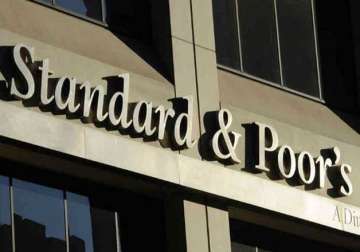S&P retains India's rating at BBB-, rules out upgrade till 2016
New Delhi: Global agency Standard and Poor's (S&P) on Monday ruled out any rating upgrade for India, though it said improvement in policymaking have raised the country's prospect for economic and fiscal performance.The agency retained

New Delhi: Global agency Standard and Poor's (S&P) on Monday ruled out any rating upgrade for India, though it said improvement in policymaking have raised the country's prospect for economic and fiscal performance.
The agency retained India's rating at BBB- with stable outlook and expressed hope that country's economic growth would average about 8% during 2015-18 period. "We are affirming our 'BBB-' long-term and A-3 short-term sovereign credit ratings on India," it said. BBB is the lowest investment grade rating and stable outlook reduces risk of possible sovereign rating downgrade.
The stable outlook, it said "balances India's sound external position and inclusive policymaking traditions against the vulnerabilities stemming from its low per capita income and weak public finances. The outlook indicates that we do not expect to change our rating on India this year or next based on our current set of forecasts," S&P said in a statement.
The agency also cautioned that downward pressure on the ratings could reemerge if growth disappoints (perhaps as a result of stalling of reforms), if, "contrary to our expectations, the new monetary council is not effective in achieving its targets, or if the external liquidity position of the nation deteriorates more than we currently expect".
However, it added upward pressure on the ratings could build if the government's reforms markedly improve its general government fiscal outturns and with them the level of net general government debt so that it falls below 60% of the GDP. "Stable outlook indicates that we do not believe India's public finances will improve sufficiently this year or the next to warrant an upgrade, nor that its economic, external, or monetary profiles will slip enough to prompt a downgrade," the agency said.
A rating constraint, S&P said is India's low GDP per capita, which "we estimate at $1,700 in 2015".
Read Also: China's GDP falls to 6.9 per cent in third quarter,weakest since 2009
India's growth outperforms its peers and is picking up modestly, it added. "Following India's early 2015 rebasing of GDP, we expect GDP growth of 7.4% in 2015 (6% in GDP per capita terms) and for it to average just under 8% over 2015-2018 (just under 7% in GDP per capita terms).
Giving rationale for retaining the rating, S&P said governing parties have made progress in building consensus on passage of laws to address long-standing impediments to India's growth. These include strengthening the business climate (such as through simplifying regulations and improving contract enforcement and trade), improving labour market flexibility, and reforming the energy sector.
"We also observe some progress in comprehensive tax reforms through the likely introduction of a goods and services tax to replace complex and distortive indirect taxes. We believe these measures, supported by India's well-entrenched democracy, will promote greater economic flexibility and help redress public finances over time," it said.
It expects that domestic supply-side factors will increasingly bind economic performance, and "we note that the government has little ability to undertake countercyclical fiscal policy given its current government debt load".
S&P said the Reserve Bank of India (RBI) is reforming is decision-making process for rate setting.
"Under a proposal that we expect to be adopted by year-end, the RBI will establish a monetary council with seven members (the RBI governor; one executive member of the RBI board nominated by the RBI board; one employee of the RBI nominated by the RBI chairperson; and four persons appointed by the government). We believe that these measures will support the RBI's ability to sustain economic growth while attenuating economic or financial shocks," it said.
That said, "we see some risk that strong inflows to the financial sector combined with higher inflation in India vis-a-vis its trading partners could pressure the real and nominal effective exchange rates, which in turn could hurt competitiveness if not matched by strong productivity growth".
The agency further said that given the weaker profitability of public-sector banks, "we estimate capital infusion needs at $35 billion (1.6% of GDP) over 2016-2019 to meet Basel III capital norms".
The government has already committed $11 billion (0.5% of GDP). "The government may have to increase the allocation if the banks are not able to secure capital from alternative sources, such as equity markets, additional tier-1 bonds and insurance companies," it said.